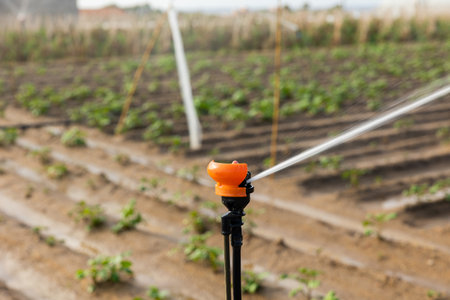1. Introduction to Drip Irrigation in India
Drip irrigation, also known as trickle irrigation, is steadily transforming the face of Indian agriculture. As farmers across the country strive to make every drop count, this method has become a lifeline especially in regions where water scarcity is a pressing concern. From the fertile plains of Punjab to the arid stretches of Rajasthan and down to the lush gardens of Kerala, drip irrigation offers a tailored solution that aligns with India’s diverse agro-climatic zones.
The traditional flood irrigation techniques, while familiar, often lead to significant water wastage and reduced crop yields. Drip irrigation, on the other hand, delivers water directly to the root zone of plants through a network of pipes and emitters, ensuring optimal moisture levels and minimising evaporation losses. This system is gaining popularity among smallholder farmers as well as large agricultural enterprises, thanks to its ability to boost productivity while conserving precious resources.
In the Indian context, where agriculture is both a livelihood and a legacy, adopting sustainable practices like drip irrigation is not just about saving water—it is about securing future harvests and uplifting rural communities. As government schemes and subsidies encourage more farmers to embrace this technology, understanding its costs and benefits becomes essential for making informed decisions. Whether you cultivate pomegranates in Maharashtra, sugarcane in Uttar Pradesh, or vegetables in Tamil Nadu, drip irrigation holds relevance for all—offering hope for a more resilient and prosperous agricultural landscape.
2. Understanding Drip Irrigation Costs
When considering drip irrigation for your farm in India, it is essential to understand the key cost components that shape your investment. Whether you are a small, medium, or large-scale farmer, these elements remain consistent across the board, though their scale and supplier options may vary with your holding size and crop type.
Key Components of Drip Irrigation System Costs
| Component | Description | Indian Context & Suppliers |
|---|---|---|
| Pipes | Mainline and lateral pipes distribute water from the source to each plant. | Commonly made from HDPE or PVC; leading Indian brands include Jain Irrigation and Finolex. |
| Emitters/Drippers | Regulate water flow directly to plant roots, ensuring uniform distribution. | Available in various discharge rates (lph) to match crop needs; local supply is robust in agri-markets. |
| Filter Systems | Prevent clogging by filtering silt and debris from water sources. | Disc and sand filters are widely used; easily sourced from regional agri-input dealers. |
| Installation | Covers labour charges for laying out the system and connecting components. | Costs vary by region, land size, and terrain; government-approved installers can be found locally. |
| Maintenance | Includes periodic cleaning, repairs, and replacement of worn parts. | Essential for long-term efficiency; annual maintenance contracts offered by many suppliers. |
Pipes: The Backbone of Drip Systems
Pipes form the arteries of your drip system, carrying precious water from borewell or canal to every corner of your field. Choosing ISI-marked pipes ensures durability under Indian climatic conditions. Pipe diameter and length will influence costs—smallholdings need less piping, while large farms might require kilometers of lines.
Emitters: Delivering Precision Watering
The heart of micro-irrigation lies in the emitters or drippers. Their spacing and flow rate must be tailored to each crop, such as sugarcane in Maharashtra or grapes in Nashik. Local suppliers offer both pressure-compensating and non-compensating types suited for varying terrain elevations found across India’s diverse farmlands.
Filter Systems: Guarding Against Blockages
Indian water sources often contain suspended particles that can choke your system. Reliable filtration is non-negotiable, especially if using river or tank water. Investing in quality filters upfront prevents costly repairs down the road—a wise choice for any progressive kisaan (farmer).
Installation & Maintenance: Sustaining Your Investment
The installation phase demands skilled hands familiar with local soil profiles—whether black cotton soil of Deccan or sandy loam of Punjab. Annual maintenance, like flushing pipes before Rabi season or checking emitters during summer heatwaves, keeps your system blooming year after year. Many Indian suppliers now bundle maintenance contracts with new installations to ensure peace of mind.
![]()
3. Cost Analysis: Small-Scale Farmers
Understanding the Initial Investment for Small Indian Farms
For marginal and small-scale farmers across India, drip irrigation is increasingly seen as a smart investment, promising both water savings and improved yields. The upfront cost of installing a drip system on farms less than 2 hectares typically ranges from ₹40,000 to ₹90,000 per hectare, depending on crop type, terrain, water source, and system quality. This includes pipes, emitters, filters, pumps, and installation labour. While these figures may seem daunting for smallholders in states like Maharashtra, Tamil Nadu or Punjab, considering the long-term benefits is essential.
Government Subsidies & Support Schemes
To make drip irrigation accessible to all segments of farmers, the Government of India—through its flagship PMKSY (Pradhan Mantri Krishi Sinchayee Yojana) scheme—and many state governments offer subsidies covering 50-80% of the total installation cost for eligible small and marginal farmers. For instance, in Andhra Pradesh or Gujarat, a farmer with 1 acre of land may pay only ₹15,000-₹20,000 post-subsidy. Awareness about local subsidy procedures and documentation can significantly reduce financial burden.
Cost-Saving Tips for Smallholders
Small farmers can further economise by selecting locally manufactured components and adopting group purchasing with neighbouring farmers. Opting for gravity-fed systems where possible cuts down pump costs and energy bills. Regular maintenance—like cleaning filters and checking for leaks—prevents expensive repairs later on. Community sharing of technical resources or forming cooperative groups also lowers both purchase and maintenance costs.
Return on Investment: What Can Small Farmers Expect?
The returns from drip irrigation are substantial: studies show yield increases of 30-50% in crops like sugarcane, vegetables, and cotton when compared to flood irrigation. Water usage drops by up to 60%, directly reducing electricity or diesel expenses. For a typical smallholder growing chilli or tomato, annual profits may improve by ₹25,000-₹40,000 per acre after accounting for higher yields and lower input costs. With government support and careful planning, most small farmers recover their investment within 2-3 cropping cycles—making drip irrigation not just a wise environmental choice but a financially sustainable one too.
4. Cost Analysis: Medium-Scale Farmers
For medium-scale farmers in India, typically managing between 5 to 20 acres, drip irrigation presents both unique challenges and lucrative opportunities. As these farmers navigate the transition from traditional watering methods to modern drip systems, understanding the expense structure and tailored solutions is crucial.
Understanding the Cost Structure for Medium Holdings
The cost for setting up a drip irrigation system on medium-sized farms varies based on region, crop type, and available infrastructure. Initial investment per acre generally decreases compared to small holdings due to economies of scale, but additional complexities may arise with larger layouts and water distribution needs.
| Expense Head | Approximate Cost (INR/acre) | Comments |
|---|---|---|
| Drip Lines & Emitters | 15,000 – 22,000 | Quality and brand influence price; longer fields may require customized emitters. |
| Pumps & Filtration Units | 8,000 – 15,000 | Medium farms often need higher capacity pumps. |
| Mainlines & Submains | 6,000 – 10,000 | Larger area increases mainline length and cost. |
| Installation Charges | 3,500 – 7,000 | Labour costs can be region-specific. |
| Total Initial Investment (Per Acre) | 32,500 – 54,000 |
Region-Specific Challenges & Solutions
Water Availability: In states like Maharashtra and Karnataka where rainfall is unpredictable, investing in water storage tanks or connecting to borewells is common. These add to upfront costs but ensure consistent water supply.
Power Supply: Unreliable power in rural UP or Bihar means many medium farmers invest in solar pumps or diesel generators.
Cropping Patterns: Sugarcane or banana cultivation requires different emitter spacing compared to groundnut or cotton—customization impacts both material and installation expenses.
Government Subsidies & Financial Assistance
The Pradhan Mantri Krishi Sinchayee Yojana (PMKSY) offers up to 55% subsidy for medium-scale farmers depending on state policies. NABARD also provides low-interest loans tailored for micro-irrigation projects. Proactive application for these schemes can significantly reduce net investment.
Benefits Realised by Medium-Scale Farmers
The most celebrated gains are water savings (up to 50%), increased yield (15-30% boost), and reduced weed growth. Labour requirements drop drastically—a major boon during peak sowing seasons when finding hands is tough. With improved efficiency, medium farmers can diversify crops and move towards high-value horticulture.
By carefully assessing costs and leveraging regional support systems, India’s medium-scale cultivators can transform their green fields into thriving gardens of prosperity using drip irrigation technology.
5. Cost Analysis: Large-Scale Farmers
For India’s progressive, large-scale farmers, investing in a drip irrigation system is a strategic decision that goes beyond immediate cost savings. The key factors to consider include scalability, integration of advanced technology, and long-term profitability. Let us break down these considerations for our big-hearted growers who manage vast acres and aspire for global standards.
Scalability: Adapting to Expansive Fields
Large farms in regions like Punjab, Maharashtra, and Andhra Pradesh require systems that can efficiently irrigate hundreds of acres. Scalable drip solutions mean modular layouts—mainlines, sub-mains, and laterals—that can be expanded as your farming operations grow. While the initial investment per acre may decrease due to bulk procurement and installation, the overall capital required is significant. However, economies of scale play a favourable role, reducing the average cost per hectare compared to smaller holdings.
Advanced Features for Maximum Efficiency
Big farms benefit greatly from smart features such as automated fertigation units, remote monitoring via IoT devices, and pressure-compensating emitters. These technologies ensure uniform water delivery even across undulating terrain and long pipeline runs typical of large Indian fields. Investing in such advanced systems comes at a premium—ranging from ₹50,000 to ₹90,000 per acre—but brings substantial returns by optimising resource use and minimising labour costs.
Long-Term Profitability: Reaping Sustainable Gains
The payback period for large-scale drip investments is typically shorter than anticipated—often within 2–4 years—thanks to enhanced yields, reduced input wastage, and government subsidies under schemes like PMKSY (Pradhan Mantri Krishi Sinchayee Yojana). Over time, lower operational expenses, improved crop quality, and higher market prices contribute to robust financial health. In addition, sustainability credentials open new export opportunities as global buyers increasingly favour responsibly irrigated produce.
In conclusion, for visionary Indian farmers managing expansive lands, drip irrigation is not just an expense but a vital investment in future-ready agriculture. With careful planning and adoption of advanced features, the journey towards higher productivity and prosperity becomes both efficient and rewarding.
6. Case Studies & Success Stories
Punjab: Small Farmer’s Journey with Drip Irrigation
In the lush fields of Punjab, Sukhwinder Singh, a small-scale farmer from Ludhiana, adopted drip irrigation (locally called “boond-boond sinchai”). Facing water scarcity and rising diesel costs for pump sets, he switched from traditional flood irrigation to a micro-drip system. The initial investment seemed steep, but government subsidies under the PMKSY (Pradhan Mantri Krishi Sinchayee Yojana) covered 70% of the setup cost. Within one cropping cycle, Sukhwinder saw a 40% reduction in water usage and a 25% increase in yield for his kinnow orchard. He highlights that proper maintenance of filters and pipes was crucial to avoid clogging due to silt—a common challenge in northern India.
Maharashtra: Medium Farmer’s Experience with Sugarcane
Vasudev Patil from Nashik district manages a medium-sized holding dedicated to sugarcane. With erratic monsoons and depleting groundwater (known locally as “jal sankat”), Vasudev invested in a semi-automated drip system financed through a cooperative bank loan and aided by state subsidy schemes. The biggest hurdle was convincing labourers about the efficiency of drip versus flood irrigation (“bavli paddhat”). Over three years, he documented savings of over ₹20,000 per hectare annually on labour and fertiliser costs, thanks to fertigation. The community now refers to his method as “smart kheti,” inspiring neighbouring farmers to adopt similar technology.
Tamil Nadu: Large Farmer Scaling Up Horticulture
In Coimbatore, R. Meenakshi manages a large horticultural farm growing pomegranate and guava. She installed a fully automated drip irrigation network covering over 50 acres. Initial challenges included sourcing quality emitters suitable for local soil conditions (“mann vishesham”) and ensuring regular training for farm workers. Despite high upfront costs (partially offset by Tamil Nadu Agricultural Department support), within two seasons she reported uniform fruit size, reduced disease incidence, and efficient use of micronutrients. The success story is often cited at local Krishi Vigyan Kendra (KVK) workshops as an example of sustainable large-scale farming.
Key Lessons Learned Across States
- Utilising government schemes like PMKSY and state subsidies significantly reduces financial burden.
- Regular maintenance—especially flushing lines and cleaning filters—is vital for consistent performance.
- Community engagement helps overcome resistance to adopting new technology.
- Customising system design based on crop type (“fasal prakar”) and soil condition leads to better results.
The Indian Drip Revolution Continues
These real-life stories from Punjab, Maharashtra, and Tamil Nadu demonstrate that with the right support, awareness, and adaptation to local needs, drip irrigation can transform Indian agriculture—whether you are a marginal grower or managing vast farmland.
7. Summary and Practical Tips
To conclude our comprehensive guide on drip irrigation cost analysis for small, medium, and large Indian farmers, let us summarise the key points and offer practical, actionable advice rooted in the realities of Indian agriculture. Drip irrigation continues to grow in popularity across India, thanks to its water-saving efficiency, increased crop yields, and government incentives. However, the initial investment can vary greatly depending on land size, crop selection, local conditions, and system complexity.
Current Trends in Indian Drip Irrigation
The latest trends indicate a shift towards smart drip systems equipped with sensors and automated controls, making water management easier for farmers in diverse regions—from the lush fields of Punjab to the semi-arid stretches of Karnataka. State and central government schemes such as PMKSY (Pradhan Mantri Krishi Sinchayee Yojana) are actively supporting farmers with subsidies and technical know-how. Additionally, micro-financing options and cooperative society models are helping smallholders bridge the initial cost gap.
Actionable Advice for Farmers
- Assess Your Needs: Always begin by evaluating your soil type, crop pattern, and water source before selecting a drip system. Consult local agricultural officers or KVKs (Krishi Vigyan Kendras) for tailored recommendations.
- Calculate True Costs: Go beyond the upfront installation price; include maintenance expenses, filter replacements, seasonal adjustments, and energy costs when budgeting.
- Utilise Government Schemes: Visit your nearest Agriculture Department office or access official portals to check eligibility for subsidies and technical support under schemes like PMKSY.
- Choose Trusted Vendors: Purchase equipment from ISI-certified suppliers or reputable brands recommended by fellow farmers or local cooperatives to ensure product longevity and service backup.
- Engage in Peer Learning: Join WhatsApp groups or attend field demonstrations organised by NGOs or agricultural universities to learn from real-life experiences of fellow farmers.
Trusted Resources for Guidance
- Krishi Vigyan Kendras (KVKs): For free technical advice and field visits
- Agricultural Technology Management Agency (ATMA): For training programmes and resource material
- NABARD & Local Cooperative Banks: For information on loans or financial assistance
- Central/State Agriculture Department Websites: For latest updates on subsidy schemes
By combining informed decision-making with locally available resources, Indian farmers—whether cultivating an acre or a hundred—can harness the full benefits of drip irrigation. Stay curious, keep learning from your peers, and embrace technology as you nurture your land for a greener tomorrow.


